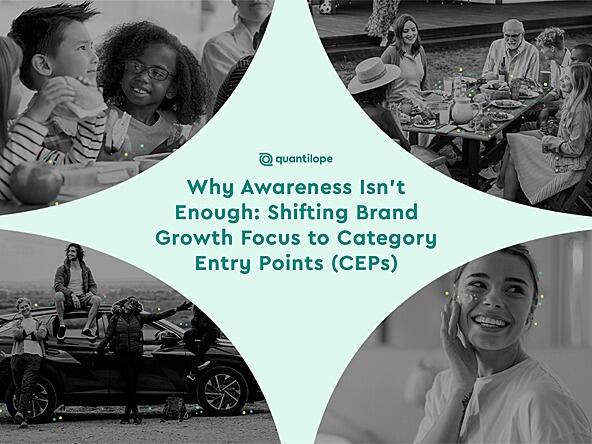Why awareness isn't enough: shifting brand growth focus to category entry points

If you don't understand what brings a consumer to your category, the chances of them landing on your brand are slim. In this article, you’ll learn what CEPs are, how they feed into mental availability and mental advantage analyses, and why they’re essential for driving brand growth. You’ll also learn how to unlock CEPs using quantilope’s CEP Generator, a free tool that allows brands to instantly generate an initial list of CEPs for their category.
What are category entry points (CEPs)?
Developed by Jenni Romaniuk and Byron Sharp of the Ehrenberg-Bass Institute for Marketing Science, category entry points (CEPs) are the needs, occasions, or situations that lead a consumer to think about a product category (such as packaged snacks or body wash). They encompass everything from a basic functional need (‘I'm hungry’) to a deeper-rooted emotional desire (‘I want to feel pampered’).
Unlike traditional market research funnel metrics – like brand awareness, consideration and usage – CEPs help brands to go a step further to understand which brands come to mind when a consumer has a particular need to solve. Understanding and tracking these category triggers over time allows a brand to develop effective strategies centred around those wants and needs.
How do CEPs relate to mental availability and mental advantage metrics?
CEPs are the foundation to measuring mental availability and mental advantage metrics (two key elements of better brand health tracking (BBHT) studies). Mental availability is the likelihood that your specific brand comes to mind in various buying scenarios (CEPs), and a mental advantage is when your brand performs significantly better within the category than expected (or worse, which would be a mental disadvantage). The more scenarios that consumers mentally ‘link’ to your brand’s category, the more chances consumers will be shopping for (and considering) your brand.
Now, simply relying on high metrics can be misleading, as larger brands and more ‘obvious’ attributes naturally score higher. For example, it wouldn’t be fair to directly compare performance metrics between a small soda company, and say Coca-Cola, nor would it be helpful to say that the top CEP for toothpaste is ‘to prevent cavities’. Nearly everyone knows of Coca-Cola, and nearly all toothpaste brands aim to prevent cavities. What brands want (and need) to know is how they perform despite these more obvious conditions, which is where mental advantage analysis comes in. Mental advantage analysis takes these elements into consideration as to not inflate or deflate metrics relative to category biases.
‘When’ and ‘why’ surpass the ‘what’
As highlighted above, understanding CEPs is a transformative step because it directly informs the ultimate goal of marketing: to increase mental availability.
Brand leaders, marketers, and insights professionals can use CEPs to effectively increase their mental availability, dominate their categories, and ultimately, grow their brand by optimising brand positioning to enter a new market, developing key messaging in campaigns, inspiring promotions and point-of-sales activations, informing new product innovation and inspiring potential brand collaborations.
Without a clear grasp of CEPs, brands risk significant and costly missteps such as:
- Wasted marketing spend: Campaigns targeting irrelevant needs fail to come to mind when consumers are actively shopping
- Irrelevant products: Investing in features that address non-existent or low-frequency consumer triggers wastes valuable resources
- Missed opportunities: Failing to see (and act on) underserved CEPs means missing huge areas for growth.
Democratising discovery: quantilope’s new CEP Generator
Recognising the impact CEPs have on brand growth, quantilope has developed an accessible, freely-available tool: its CEP Generator. This new tool ensures any brand, regardless of size or budget, can quickly gain a strategic starting point for ongoing consumer intelligence. Users simply visit quantilope’s website, provide basic category details, and the CEP Generator – leveraging a sophisticated application of AI and marketing science – instantly curates and delivers a detailed pdf report containing 35 initial CEPs directly to their inbox.
From initial CEPs to lasting brand insights
While the 35 generated CEPs offer a robust starting point, the ultimate goal is to refine this list within a full BBHT study to uncover category white space, expand offerings, attract new customers, and accurately monitor brand health against key metrics like mental availability and mental advantage.
Informed decisions are more than just a ‘nice-to-have’; they’re essential for strategic, long-term growth and relevance. quantilope’s CEP Generator gives you a head start in transforming vague business aspirations into concrete, category-winning strategies.

We hope you enjoyed this article.
Research Live is published by MRS.
The Market Research Society (MRS) exists to promote and protect the research sector, showcasing how research delivers impact for businesses and government.
Members of MRS enjoy many benefits including tailoured policy guidance, discounts on training and conferences, and access to member-only content.
For example, there's an archive of winning case studies from over a decade of MRS Awards.
Find out more about the benefits of joining MRS here.













0 Comments